By Tony Cook
The Hobby Industry Association of America (HIAA) annual trade show was an institution in model railroading at one time. The event took place in Chicago, Illinois, and presented a platform for manufacturers to introduce new products, meet the public, and — most importantly — solicit orders from hobby shops.
I always found this show to be exciting, having attended a number of times over the years. Back when new product information was much less easy to secure, these trade shows often marked the first appearance of a new product announcement and sometimes the actual display of early samples. If memory serves, one of the last times my father and I attended the annual Chicago show (around 2000), we saw the debut of Atlas’ HO-scale GP40. Sitting at the manufacturer’s booth was a silver-painted HO GP40 that naturally attracted its share of interested admirers. The show today doesn’t generate the same involvement with the model railroading segment of the hobby, and manufacturers tend to make big announcements in the fall at Trainfest in Milwaukee, Wis., or during The National Train Show following the NMRA National Convention held in different cities each year during the summer.
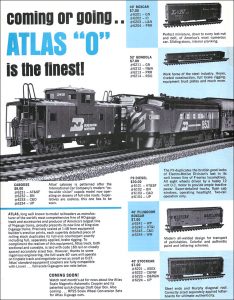
This ad is how many modelers discovered Atlas was entering the O-scale world. This “coming or going” ad appeared in January 1972 editions of Railroad Model Craftsman and Model Railroader magazines.
For its early 1972 installment, Atlas surprised HIAA show attendees with a new line of O-scale models. The first ads promoting Atlas’ O-scale appeared in January 1972 editions of hobby magazines. The full-page “coming or going” ad showed off the first Atlas O-scale releases to arrive in 1972. This line launched with an F-unit, four freight cars, and a caboose.
The new product line provided 2-rail O-scale operations with plastic models produced in Austria by Roco for Atlas. Known for its line of track, this entry into the 1/48 sector of model trains marked Atlas’ first time selling O-scale track. The track followed Atlas snap-track style with molded plastic ties and nickel-silver Code 160 rails. In addition to electrical contact with traditional rail joiners, the ends of the track segments included a tab-and-slot design to help keep the pieces connected.
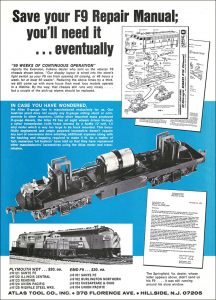
This 1973 ad shows in the inner workings of Atlas’ F9A diesel model. Also promoted is the reliable performance with notices from two hobby dealers praising the ability of this O-scale F9A.
Tony Koester presented these O-scale models in his column published in Railroad Model Craftsman’s May 1972 edition. Koester wrote, “The superb detail make this line an exceptional value for the newcomer and veteran alike.” The debut motive power presented an Electro-Motive Division (EMD) F9A diesel locomotive model. The four freight cars included 40-foot sliding-door and plug-door boxcars, as well as a stock car and a 53-foot gondola. The Atlas O caboose provided a mid-1960s wide-vision prototype. The caboose and three 40-footers included rooftop running boards. The models rolled on plastic friction-style sideframe trucks with plastic wheels. The line’s motive power and rolling stock came fitted with non-functioning plastic knuckle couplers with a long straight pole sticking out of the bottom of the coupler’s knuckle at the shank. Those couplers came mounted on most equipment to allow operation on tight curves. Though the line’s design was 2-rail, Atlas acknowledged the leader in O with the statement that its 40-foot cars would work on O27 curves, and the provided non-functioning couplers mated with Lionel equipment.
Atlas’ O-scale F9
While many of the selections in the early-1970s Atlas O-scale line featured counterparts offered by Roco in other scales, the F9A diesel was a unique tooling not duplicated elsewhere. By contrast, the 40-foot plug-door boxcar and wide-vision caboose could be found in AHM’s line as Roco-made models in HO. The plug-door boxcar also had an N-scale equivalent at the time. For collectors who don’t dabble outside their scale of choice, I highly recommend seeking out same-tooling models appearing in other scales as curiosities for your collection.
Packaging for Atlas O-scale included a white cardboard box with black and red lettering. An Atlas logo, included on all boxes, featured the face of an F-unit with Pennsylvania Railroad stripes on its nose with the hobby manufacturer’s name in all lower case red letters. This design contrasted with a steam locomotive face in a similar design used for Atlas N-scale of the day and the EMD GP or SD nose featured on HO packaging of this same vintage. Purchasers received diesel models packed in a foam tray inside the window-display white Atlas box. Freight cars came in similar boxes but secured with cardboard cutout liners.
The F9A diesel model retailed for $30 and was a powered release only. Road names for Atlas’ F9A included Burlington Northern (#6102), Chesapeake & Ohio (#6103), Santa Fe (#6101), and Union Pacific (#6104). The newest livery produced for this F9A was the Cascade Green Burlington Northern scheme. The appearance included the “hockey stick” early example of Burlington Northern’s 1970 debut colors. The other offerings, (Chesapeake & Ohio (blue-and-yellow), Santa Fe (Passenger Warbonnet), and Union Pacific, featured older liveries dating from the 1940s. No additions to the F9A’s roster came during the model’s time with Atlas.
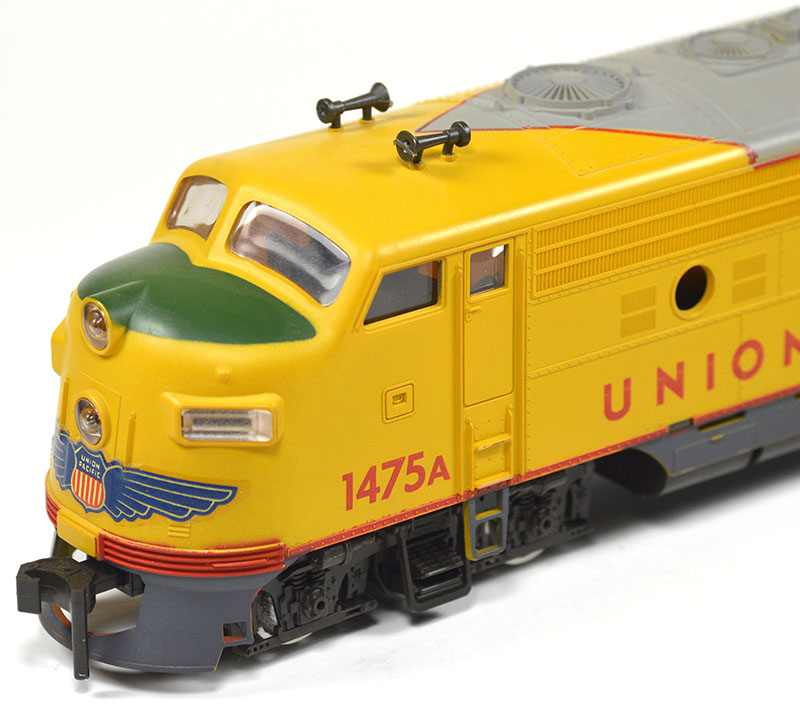
The F9 shell was essentially a single-piece effort with handrails and grab irons molded on the shell. A close examination of the nose reveals seams between the classification lights and number boards. Those lines stop on the inner edges of the number boards and run straight down the nose facing. This design is similar to Kato’s approach to F-units in N scale, as well as ones built originally for Stewart Hobbies in HO that now reside in Bowser’s line. Those lines provide some insight into the sections or “slides” that made up the mold to create plastic models. The F9 features twin headlights, 48-inch dynamic brake, and steam generator details on its shell. Clear inserts appeared in the headlights, number boards, and windshield and side cab windows. The portholes on the unit’s side and rear door included no clear plastic window material. Two single-bell air horns reside on the top of the cab roof. These were separate plastic details provided to the model in a raw milky-gray-black hue. This raw plastic for details extended to ladders, handrails, and smoke stacks on rolling stock.
A review in Model Railroader’s July 1972 edition stated the 12-volt DC motor could operate in scale speed ranges from 7 to 80 mph. The F9A weighed in at 32 ounces and could navigate curves down to 24-inch radius. A large, round can motor sat over the tanks on a plastic frame. My experience with an Atlas O-scale F9 is limited to a set received for Christmas in 1974. I remember Atlas O-scale as being great looking and well-detailed models, which was especially true for the sideframe details on the F9A. I also distinctly remember the models operating smoothly.
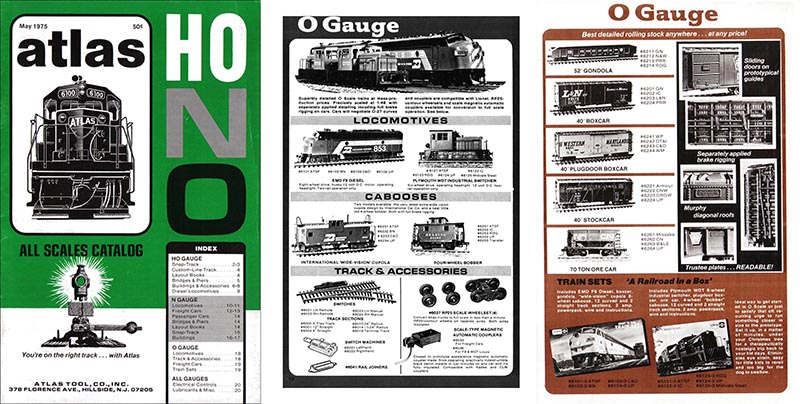
This 1975 Atlas catalog provides a look at what ended up being the complete O-scale line from the 1970s. In addition to the F9A and industrial diesel switcher, you could select from five freight cars and two caboose models. Track included turnouts (remote and manual), straights, 36-inch flex pieces, and curve sections limited to 24-inch radius curves. Scale wheels with RP25 flanges and working scale magnetic couplers also came
The round can motor reportedly is the same device Roco used in E-units marketed by Model Power at about the same time in the early-to-mid 1970s. A 1973 Atlas ad boasts a letter the company received from an un-named Indiana dealer that saw trouble-free operation with an O-scale F9 running from open-to-close at this store for nearly a year straight.
Sadly, this initial attempt at O-scale wasn’t an overwhelming success for Atlas. I remember liking my Burlington Northern F9 set but soon was back in HO full-time after Christmas due to a lack of additions to the catalog. By the end of 1972, Atlas added a Plymouth MDT industrial diesel switcher, a four-wheel bobber caboose, and an ore car to its O lineup… then nothing more. No new road names for the existing equipment and no new locomotives or rolling stock. This same mid-1970s period was exploding with new companies entering HO, and established hobby manufacturers kept adding new items that held my attention and sidetracked my interest in O-scale. One story I’ve recently heard about Atlas and Roco claimed the slow sales for the 1972 O-scale line might have led to Roco’s production of the run of HO EMD diesels (SD24, SD35, GP38, GP40, and FP7) beginning in late 1974 and into 1976 for Atlas’ line.
Atlas’ early 1970s O is still a product line that fascinates me. Just getting out my Union Pacific F9A diesel example and examining it makes me think I need to collect the other road names for a complete set! Today’s Atlas O-scale offers are many and ever-expanding. As this issue’s cover story review by David Otte shows, the contemporary Atlas O-scale F-unit is quite a ways ahead of the 1972 original that launched the company into this popular segment of model railroading.
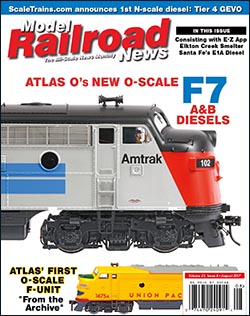 This article appeared in the August 2017 issue of Model Railroad News. Subscribe today!
This article appeared in the August 2017 issue of Model Railroad News. Subscribe today!



